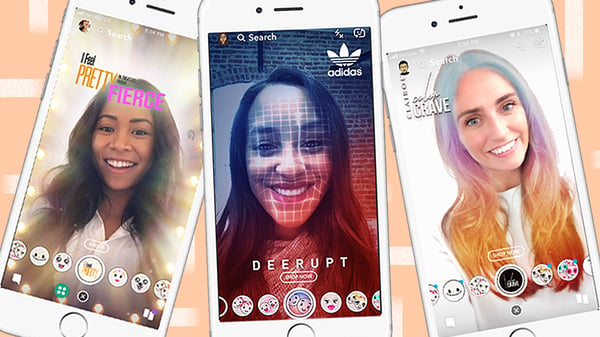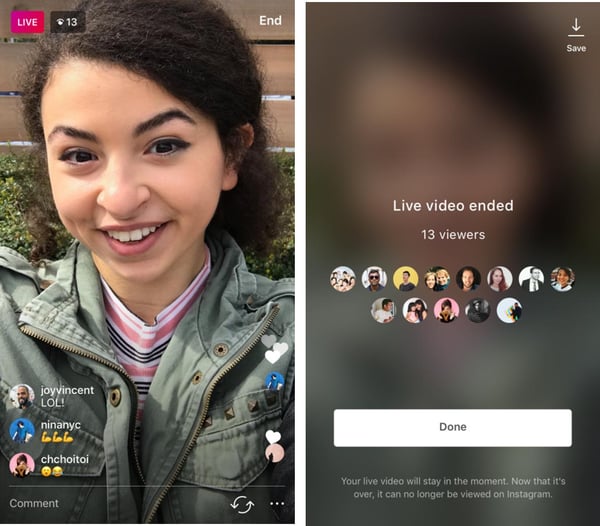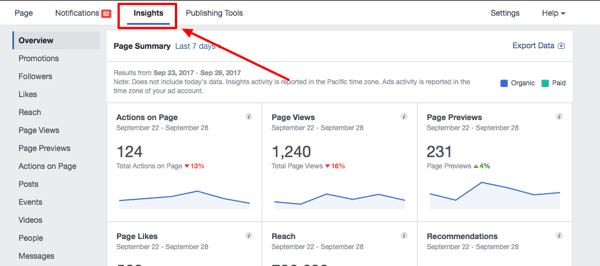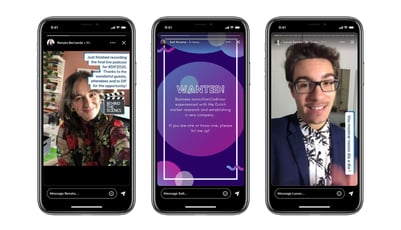A new way of marketing
Since Snapchat entered the scene in September 2011, social media has never been the same. Over these last 10 years, all other prominent platforms have adapted their own version of Snapchat’s “Stories;” including Instagram, Twitter, Facebook, LinkedIn, and even Pinterest too. The stories feature has impacted the way marketers approach their marketing practices and consumers' social media habits too. Let’s take a look into what exactly is happening on our social media platforms’ Stories, Reels, and Fleets.
What is a …
Snapchat Story
Five years after the app was released, Snapchat had 150 million active daily users. And in 2020, Snapchat had 229 million daily users. They were the first social media platform to introduce disappearing content, now commonly referred to as “Stories” across platforms. The basic idea of Stories is that users can share content temporarily - it disappears after 24 hours. This creates a sense of urgency and ignites FOMO (the Fear Of Missing Out) amongst Snapchat followers.
On Snapchat, marketers have the option of promoting their brand organically via Stories, or through Snapchat’s paid ads capabilities. If you have a Snapchat Business account (which you should) you can access insight features to measure metrics like views, reach, and demographic information for your followers. A great way to attract engagement on Snapchat is by creating branded filters or AR lenses- especially since 75% of Snapchatters use AR lenses every day. For inspiration, see how the biggest brands did the best filters as part of their Snapchat Marketing strategy.

Instagram Story
Instagram Stories are found at the very top of the app’s feed and are a horizontal, rolling carousel of temporary content that, like Snapchat Stories, disappear after 24 hours. These feature customizable stickers ranging from GIFs to polls, to Q&A - all of which are a big-time boost for consumer engagement and loyalty. More than 70% of Instagram users view Stories on a daily basis, and the average user typically spends 24 to 32 minutes scrolling through Stories every day.
For brands with a bigger target audience on Instagram, Stories are perfect for posting live videos, behind-the-scenes content, and announcements for new products or events. These types of content, when combined with interactive customizable stickers, can send your follower engagement and customer loyalty rates soaring.

Facebook Story
Facebook Stories are found in the top right corner of the platform’s feed of the desktop screen, and right front and center at the top of the app’s feed. Like Instagram, can be scrolled through horizontally. This feature was launched in 2017, but only 10% of Facebook’s 1.45 billion daily users have actually taken to using it. Facebook launched Stories as a part of a larger effort to move towards more authentic, interactive content between friends and family - not businesses, brands, and media. So with Facebook Stories, authenticity is key.
Facebook Stories has fun features like stickers, filters, and tags - all of which can give you follower engagement rates a big boost. When you use Facebook Insights, your Facebook Story metrics will be available for viewing for 28 days afterward. With Facebook Insights, you can measure and monitor 14 different metrics including sticker interactions, views, and link clicks. You can read more about Facebook Insights here.

LinkedIn Story
Linkedin launched their version of stories in October 2020. LinkedIn Stories lay at the top of the feed, and function much like their Instagram and Facebook equivalents; they serve to engage and entice with their 24-hour lifespan. LinkedIn Stories are used for professional tips, corporate Q&A’s, brand announcements, product reveals.
LinkedIn marketers should use Stories to show the behind-the-scenes, boast about their team’s hustle, or even convert followers and connections into customers. Place CTA’s at the end of your Linkedin Stories to drive your connections to read your business’ blog, see your new product release, or sign up to attend an online conference or event put on by your company.

Twitter Fleet
Fleets = fleeting tweets. Fleets are Twitter’s version of temporary, 24-hour content, except this feature is only available on the mobile version of the app. If your target audience is on Twitter, you can reach them through fleets by posting limited time-offers, Q&A’s, and re-sharing customer content. Fleets were released in late 2020, and though there are fewer options for personalizing Fleets than other platforms’ social media, it is projected to be a successful feature for businesses on Twitter.
Twitter created this feature for people’s more casual, personal thoughts, so users may be more comfortable sharing their opinion since it disappears after one day. Fleets can be anywhere from 6-30 seconds, but keep in mind that social media users stay engaged for an average of 10 seconds before they drop off of story posts. When sharing content on Twitter Fleets, keep your images or videos direct, eye-catching, and concise.

Leveraging Ephemeral Marketing
So what do all these social media features have in common? And why does the rise of social media stories mean the fall of the social media feed? Though the purposes and capabilities of Stories vary across platforms, they are all ephemeral content.
Ephemeral marketing content is a new(ish) type of marketing that emerged in recent years. It is classified as content that is temporary and only available for a limited amount of time. Ephemeral content is likely successful because of is its short lifespan, which taps into viewer urgency, and elicits an immediate response. With a desire to be in-the-know and up-to-date, Stories engagement on social media has been on the rise; why scroll through the feed, when Stories content won’t be there tomorrow? You have to get in on it while you can.
Video Content is bigger than ever
It’s hard to talk Snapchat without talking about its increasingly popular cousin, TikTok. The rise of TikTok has only continued to feed into the growth of ephemeral marketing, and into the increasing popularity of video content too. TikTok, video, and ephemeral marketing all come together to create the perfect storm of irresistible social media content.
TikTok in Marketing?
As soon as you open the app, it is clear TikTok prioritizes content above all else. Video fills the screen with small accent buttons on the side to allow access to likes, comments, and sharing posts. It is easy to get lost in the experience of infinite scrolling on this app. This social media platform boasts endless possibilities with remixing and personalizing content. On TikTok, anyone can be a content creator, and that’s just one reason it’s so popular.
One of the best organic ways to market your brand on Tik Tok is to post a TikTok challenge. A TikTok challenge is essentially a replicable post that trends via hashtag, and somehow incorporates an element of your product or branding within it. The best TikTok challenges have clear, easy to follow rules, and should be funny or clever to execute (to capture users’ attention).

Instagram Reels
Reels are Instagram’s response to its competitor TikTok. On Instagram Reels, users can create short videos set to music and filters, but unlike Stories, these short videos are permanently stored on a user’s profile page. This feature was launched earlier in 2020, and has been slower to take off in comparison with rival TikTok but is still growing.
Marketers: use Reels to show off your product or service in action, to introduce challenges (a la TikTok), or share how-to content relevant to your company’s industry. Since Reels is a relatively new feature on Instagram make sure you put time and energy into social listening to read into what other brands in your industry are doing in their Reels marketing.

Why Video Marketing is a Winner
To put it simply, video content is more enticing to consumers. Social media users can look at any static image post but they can experience a brand, message, product, or story in a much more exciting movement with combined imagery and sound of video content. Studies show that in 2021, video marketing spend will grow to nearly $15 billion dollars, which makes sense, considering that 76% of US adults buy a product after watching a video about it.
Video and ephemeral content by themselves are incredibly engaging and thumb-stopping for today’s social media users. When marketers combine these two content types, they become doubly effective in increasing engagement, impressions, and beyond. Whether you post Snapchat ads, organic TikToks, start creating Instagram Stories and Reels, or leverage user-generated reviews on Facebook, your ephemeral and video content is sure to win.




